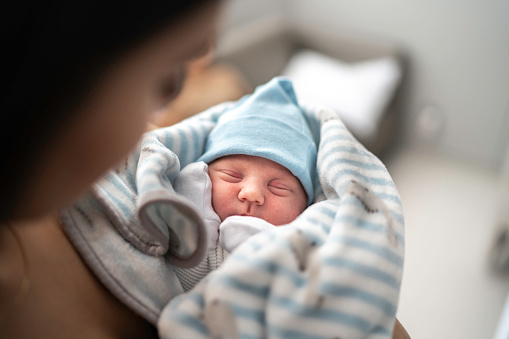By Colleen Whatley, MSN, CPPS, CNS-BC, Senior Quality and Safety Specialist, Quality Assurance and Safety, Dartmouth Hitchcock Medical Center
Newborns rely on caregivers, parents, and hospital teams to meet their needs and keep them safe while in the hospital. And for this reason, newborn falls (when held by caregivers and slip from hands or arms landing on another surface) are a significant safety concern.
Fortunately, while most newborn falls do not result in serious injury, a fall can lead to temporary separation of the newborn from their caregiver, imaging with radiation exposure and possible sedation. In addition to the newborn, the caregiver often experiences various levels of distress, especially if the fall occurred while the newborn was in their care.
At Dartmouth Hitchcock Medical Center (DHMC), we sought to reduce newborn falls through a multifaceted intervention. Our efforts are detailed in this study from the October 2022 issue of The Joint Commission Journal on Quality and Patient Safety (JQPS).
Contributing Factors: Caregiver Fatigue and Caregiver Slips/Trips
Our team conducted an initial root cause analysis of three newborn fall events and found caregiver fatigue as the most common contributing factor. Later, an analysis of 10 events revealed two contributing factors: caregivers who fell asleep and caregivers who slipped/tripped while holding a newborn.
To address the contributing factors of newborn falls and prevent them, we assembled a Newborn Fall Prevention Quality Improvement (QI) Committee to implement a series of interventions of best practices and strategies, including:
- Developing and revising a Newborn Fall Risk Assessment tool based upon the work done by Ainsworth, et al. This tool stratifies risk into three categories with associated interventions aimed to prevent newborn falls.
- Designing visual cues to remind caregivers and staff of the risk for newborn falls, whether in the Mother-Baby Unit, Intensive Care Nursery or Pediatric Department.
- Creating a case-based education tool for nursing staff that is embedded within each unit’s onboarding process.
- Developing a standardized response to newborn falls through a collaborative, interprofessional team. This was later expanded to any infant fall within the facility.
- Thoroughly analyzing the care environment:
- reinforcing the need to place caregiver beds in their lowest position
- coaching caregivers to keep side rails up when feeding their newborn
- using medical/surgical caregiver beds that offer the lowest bed position, when possible
Positive Feedback
Since implementation we have received positive feedback from caregivers and staff. Many caregivers find it difficult to believe that anyone could fall asleep while holding their newborn. However, most caregivers and staff can relate to “micro sleep” or “nodding off” and recognize that it can be a warning sign of fatigue and trigger them to unexpectedly fall asleep. We advise putting the newborn in a safe place and taking a 20-minute nap can refresh caregivers and allow them to proceed safely with care.
Additionally, staff find that the risk assessment tool offers an objective way to identify a fatigued caregiver and provides consistent interventions. The risk assessment tool also offers continuity for the family as a newborn is cared for by multiple staff during their stay. Staff also appreciate having a standardized process to follow when a fall occurs.
Tips to Implement Newborn Fall Prevention Program
When implementing a newborn fall prevention program, it can be difficult to determine where to start. While limited at the time, we found that conducting a current literature review provides innovative ideas to prevent newborn falls. Below are some tips that may be helpful:
- Build an improvement team with all involved stakeholders. This ensures that no matter where an infant is admitted, they receive standardized care to prevent a fall. And, if one does occur, a standardized approach to post-fall care takes place.
- Be open to outside perspectives as they often provide further insight. Seek the voice of the caregivers. Become a preceptor for an RN completing their master’s program who can temporarily join the team.
- Collaborate with other perinatal centers within the region.
- Stay the course and trust that improvement will come.
To date, DHMC’s Mother-Baby team has celebrated more than 700 days since the last infant fall within our facility, and more than 2,000 days since recording our first newborn fall event which resulted in moderate harm. We are delighted to report the success of our newborn fall prevention efforts.
For more information on newborn falls, please access The Joint Commission’s Quick Safety advisory, “Preventing newborn falls and drops.”
Colleen Whatley, MSN, CNS-BC, is a Senior Quality and Safety Specialist with the Quality Assurance and Safety Division at Dartmouth Hitchcock Medical Center and Children’s Hospital at Dartmouth Hitchcock Medical Center, Lebanon, New Hampshire.



